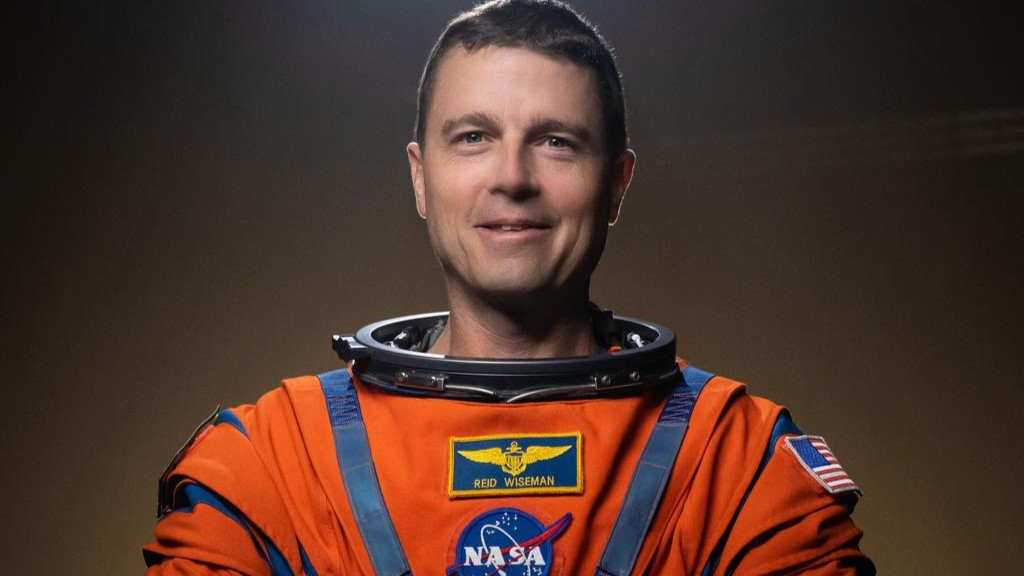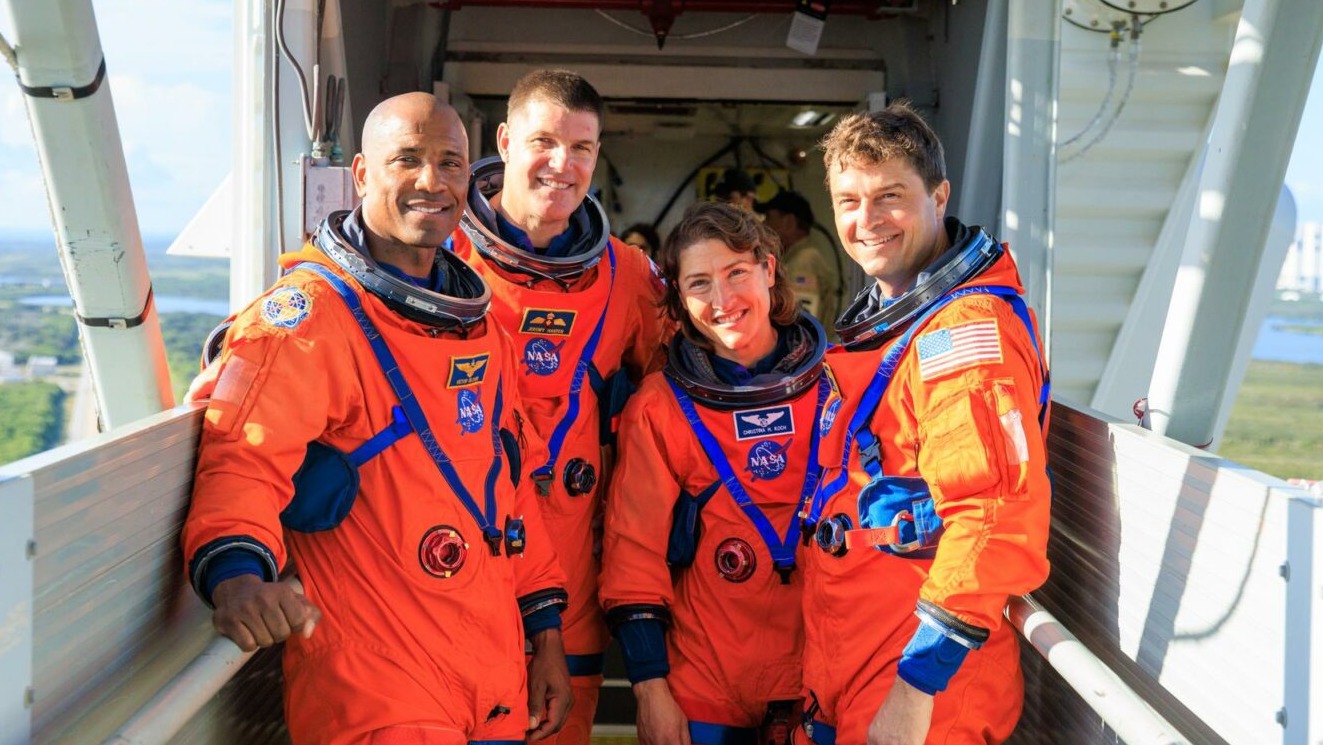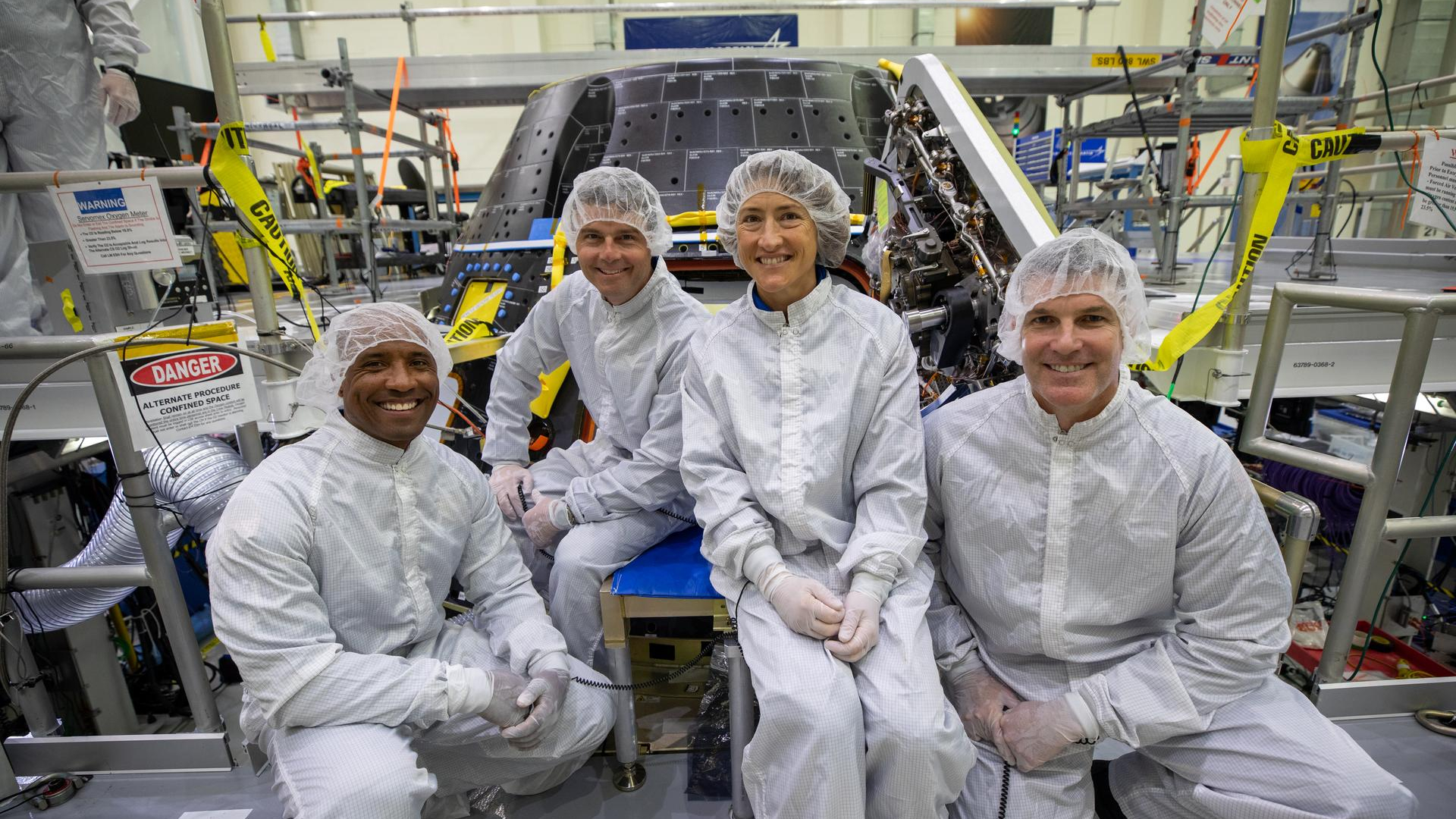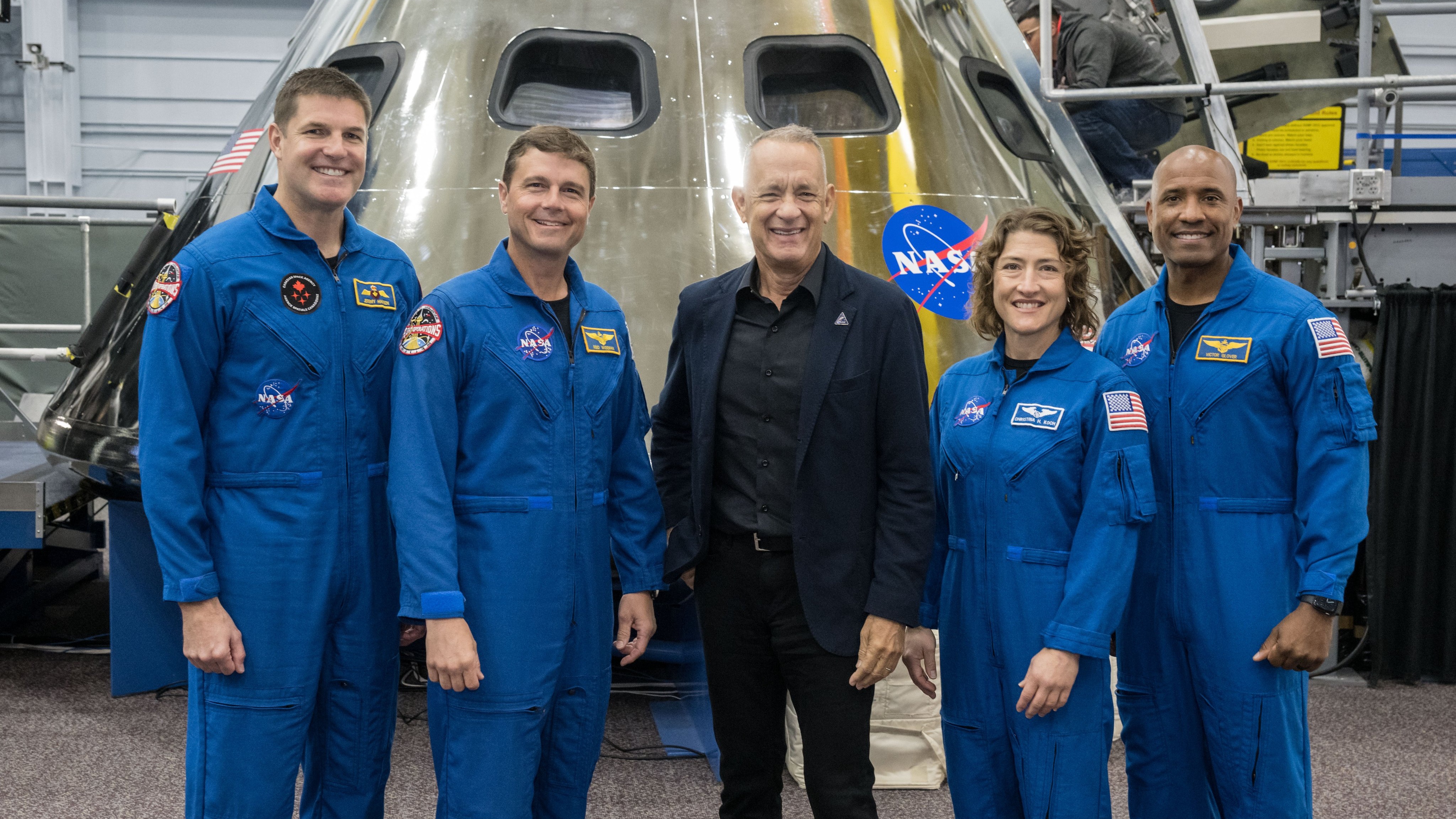Artemis 2 moon crew invited to visit SpaceX to talk Starship (exclusive)
"This is an amazing time to be a part of this program."

The commander of humanity's first moon mission in half a century has a special invite from SpaceX in his pocket.
Reid Wiseman, the NASA astronaut leading the four Artemis 2 crew members, told Space.com in a Dec. 18 exclusive that SpaceX wants to talk to his crew about Starship. That's no coincidence, given that SpaceX is developing Starship for Artemis 3, which intends to land humans on the moon for the first time since 1972.
When and how that all comes together is not known yet. Artemis 2 is expected to fly around the moon no earlier than 2024 if schedules hold. Artemis 3 is manifested for 2025 or 2026, but that assumes that SpaceX's Starship has passed enough tests to satisfy NASA's strict safety requirements for human-rated spacecraft.
Wiseman spoke with Space.com not only about SpaceX, but what his crew plans to take along with them on the mission, the outreach he has been doing, and how his crew is dealing with developmental uncertainty. Riding to the moon with him (and back) are NASA pilot Victor Glover (who will become the first person of color to leave low Earth orbit), NASA mission specialist Christina Koch (the first woman) and Canadian Space Agency mission specialist Jeremy Hansen (the first non-American).
Related: NASA's Artemis 3 astronaut moon landing unlikely before 2027, GAO report finds
We're about a year out from the launch of Artemis 2. Can you talk about your main goals for the mission, and what you're focusing on as a crew and as a team right now?
Reid Wiseman, Artemis 2 commander: It's pretty basic for us. We really want to enable the Orion and the Space Launch System for our fellow astronauts that are going to go land on the moon and work in the lunar vicinity. So every day we show up to work.
It just happened in a class we were just in: We are not only looking at how to make this better for Artemis 2. We're thinking about, "How do we position this for Artemis 3, 4, and 5?" Victor Glover today — we were talking about, "Hey, it [Artemis 2] is just a nine-day mission." We were in a survival class, but we said, "We won't be that deconditioned [after the mission]." And Victor was like, "Hey, wait a minute. We have to think about the max mission duration, because this will be valid for all Artemis missions."
So we've done — I think — an awesome job of just really looking at, what does this vehicle need for the future for our crewmates, when they go and land on the moon? How can we wring out Orion and SLS so that when our peers are training for moonwalking missions, that is almost just a basic in that [they think], "Okay, we know Orion. So we don't have to worry about that [spacecraft]. Let's instead focus on the HLS [human landing system spacecraft] or, let's focus on the new suit designs." That's really our fundamental goal.
Training has been fantastic, really well-prepared classes. It kind of comes in little waves. We're really busy, in the last few weeks, and then we have a little bit of down time. Then you're really busy again.
Can you talk about the excitement that all the teams are feeling for Artemis 2, along with the responsibilities?
Wiseman: It completely has blown me away, and not just on the professional side, but on the outreach side,to traveling around the world. Seeing where the European Service Module was built in Bremen, Germany with Airbus. Those people are so fired up to have humans riding on their vehicle. Or going into the Cape [Canaveral area] with Lockheed and Orion. I even got a call two weeks ago from the lead engineer at SpaceX. He was like, 'Next time you guys are at Cape [Canaveral, nearby NASA's Kennedy Space Center), come by and talk to us. We're doing Starship, and Dragon, and we just want to hear what is going on with the Artemis 2 crew."
I had to take a step back. They launched two Starships [in 2023], and got another one rolling onto the pad. Here they want us to come talk to them, because they are just motivated. Then of course, there are the teams that we're training with, especially at NASA. A lot of these folks, this is their career. Their career is spent preparing for us to go work on the moon. So to be a crew, marching towards a launch, it's far more meaningful for them than it is for us. We really try to embrace that. It's very powerful.

Any surprises with the training?
Wiseman: My surprise might be a little cliche. We figured — as the crew that's going to fly this vehicle for the first time — there are going to be so many unknowns. We're going to work our way through a really rough training syllabus. But what I neglected was, we're being trained by the flight controllers who just operated Artemis 1 [an uncrewed mission around the moon in 2022] very successfully. So we go into these classes, and they are just polished. They know everything there is to know about this vehicle. They just got done flying it, and around the moon. They know their systems. So there, it's just wired. I've been very impressed. They really know what's going on.
Your crew has emphasized that Artemis 2 is very much a developmental mission. So you're informed in making this mission by decades of spaceflight experience at NASA, even among all the crew. However, many of the procedures and training facilities are being created as you train. So as such, how's everybody doing on the timeline for launch?
How would NASA deal with any ripple effects in scheduling later Artemis missions if this one happened to be delayed?
Wiseman: You know, as a crew, we don't get into the programmatic of, "We ought to launch in November of 2024." There's political implications. There's operational implications. What we really care about is when this vehicle is ready, and when NASA says it's ready to go fly, we will be prepared to go fly it. That is our critical milestone. But as they're going through assembly, I think we're gonna face a little bit of a slip. For sure. So we'll see how that goes.
But I think so far, everything that I'm seeing is coming along very logically. Very methodically. And when the Orion program, or SLS, has hit a snag, we have stopped the appropriate amount of time. We're really analyzing, "Do we need to fix this? Do we have an operational workaround? Do we have a hardware workaround?" And then we're proceeding on.
I think everything has been, and what I have seen is, a safety culture. The mission assurance culture right now has been extremely healthy. We're very methodically going along at a great pace to fly when this vehicle is ready.

Have you and the crew discussed the personal items that you're taking to the moon, yet?
Wiseman: We are pretty weight-limited, but we do all have little things. I won't speak for the rest of the crew, but my whole life, I've realized how important tradition is to me. Things that I do with my children, or that my parents did with me and my brother growing up. So I will take something that nods to my personal family tradition, just as a personal token to myself.
When I flew on the Soyuz in 2014 [to the International Space Station], on my kneeboard, I had a little black-and-white picture of my kids just printed on the piece of paper, because mass is everything. So you don't take anything extra that you don't need to take. So I printed it directly on my kneeboard, and I'll do something very similar to that.
But to be honest — I didn't think about this when we first got assigned — but I get to work with Victor, Christina and Jeremy. I just want to be immersed in this experience with them. They are such special people. So I just can't wait to watch them operate as we head out around the moon.
How have you in the crew been engaging with NASA personnel, contractors, when visiting facilities and training locations?
Wiseman: We've been heading absolutely everywhere. The thing we have to remind ourselves, is everywhere we go, people know who we are. It is amazing to see just how excited people are. I mean, they are so fired up. We went to Marshall Space Flight Center, one of our own NASA centers, and we stood for an entire hour as people just took picture after picture after picture. Just walking up to the crew. We are just a human representation of what these people have been working for for over a decade. It's just so powerful.
As a group, you've been making a lot of other types of appearances. For example, you were beside Apollo 13 movie actor Tom Hanks — a moon astronaut in the movies, of course. You were also at the F1 car racing event, and many other places. Can you talk about what that experience has been like for you and the crew?
Wiseman: That is definitely surreal, because we're in places that most people don't get a chance to experience. Tom Hanks — he had a formative place in my childhood with "Apollo 13," and with "Forrest Gump." Just to get to meet these people, and to interact a little bit, has been really neat. But you know, if you gave us our wishes, we would be at a fifth-grade class trying to motivate kids to go study STEM [science, technology, engineering and math].
But this is important. We need all elements of outreach to get the message as far and wide as we possibly can, that this is worth doing. Human exploration is important to bring our world together. We can tackle big problems when we work together. So that's the message we want to send. Having people like Tom Hanks involved, and getting to F1 — getting to a few markets that typically we don't get to — has been cool.
It was fun to be immersed in the Formula One parallels between that, and Mission Control and spaceflight. The way they communicate — the way they structure and organize the things that matter to the drivers, and then the different things that matter to the engineering teams — I took a lot away from Formula One.

Is there anything else you would like to talk about?
Wiseman: I just want to really thank you for what you all do at Space.com. We have a lot of great, great learning from you guys, and I appreciate the research that you do and showing up [at the events]. I think it's really important.
I love the public-private partnership of Artemis. I don't think we do a good enough job highlighting just how that is going. The CLPS [commercial lunar payload services program, or robotic missions in support of Artemis] are going to launch soon, with robotic missions to the moon. And what SpaceX is doing, and now Blue Origin is coming on, with the HLS design. When you're when you live in this and you marinate in it, it's just awesome. This is an amazing time to be a part of this program. So we really appreciate the public support.
This interview has been edited and condensed.
Get the Space.com Newsletter
Breaking space news, the latest updates on rocket launches, skywatching events and more!
Join our Space Forums to keep talking space on the latest missions, night sky and more! And if you have a news tip, correction or comment, let us know at: community@space.com.

Elizabeth Howell (she/her), Ph.D., was a staff writer in the spaceflight channel between 2022 and 2024 specializing in Canadian space news. She was contributing writer for Space.com for 10 years from 2012 to 2024. Elizabeth's reporting includes multiple exclusives with the White House, leading world coverage about a lost-and-found space tomato on the International Space Station, witnessing five human spaceflight launches on two continents, flying parabolic, working inside a spacesuit, and participating in a simulated Mars mission. Her latest book, "Why Am I Taller?" (ECW Press, 2022) is co-written with astronaut Dave Williams.
